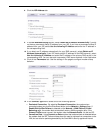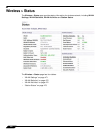
467
SonicOS 5.8.1 Administrator Guide
CHAPTER 34
Chapter 34: Viewing WLAN Settings, Statistics, and
Station Status
Wireless Overview
Note The wireless features described apply only to SonicWALL appliances equipped with internal
wireless hardware, such as the TZ series, the NSA 220W, and the NSA 250MW.
The SonicWALL Wireless security appliances support wireless protocols called IEEE 802.11b,
802.11g, and 802.11n commonly known as Wi-Fi, and send data via radio transmissions. The
SonicWALL wireless security appliance combines three networking components to offer a fully
secure wireless firewall: an Access Point, a secure wireless gateway, and a stateful firewall with
flexible NAT and VPN termination and initiation capabilities. With this combination, the wireless
security appliance offers the flexibility of wireless without compromising network security.
Typically, the wireless security appliance is the access point for your wireless LAN and serves
as the central access point for computers on your LAN. In addition, it shares a single broadband
connection with the computers on your network. Since the wireless security appliance also
provides firewall protection, intruders from the Internet cannot access the computers or files on
your network. This is especially important for an “always-on” connection such as a DSL or T1
line that is shared by computers on a network.
However, wireless LANs are vulnerable to “eavesdropping” by other wireless networks which
means you should establish a wireless security policy for your wireless LAN. On the wireless
security appliance, wireless clients connect to the Access Point layer of the firewall. Instead of
bridging the connection directly to the wired network, wireless traffic is first passed to the
Secure Wireless Gateway layer where the client is required to be authenticated via User Level
Authentication. Wireless access to Guest Services and MAC Filter Lists are managed by the
wireless security appliance. If all of the security criteria are met, then wireless network traffic
can then pass via one of the following Distribution Systems (DS):
• LAN
• WAN
• Wireless Client on the WLAN
• DMZ or other zone on Opt port


















